Microsoft's Nostalgic Surprise: Classic MS-DOS Editor Now Available on Linux
In a move that would have seemed impossible during the height of the operating system wars, Microsoft has quietly released its iconic MS-DOS Editor for Linux systems. The text editor that defined command-line editing for millions of DOS users in the 1990s is now freely available through GitHub, marking another unexpected chapter in Microsoft's ongoing embrace of open-source platforms.
A Blast from the Computing Past
The MS-DOS Editor, known simply as "EDIT" to generations of programmers and system administrators, was the go-to text editing solution during the golden age of DOS computing. First introduced with MS-DOS 5.0 in 1991, this blue-screened, menu-driven editor became the training ground for countless developers who cut their teeth on batch files, configuration scripts, and early programming projects.
What made the DOS Editor special wasn't its advanced features—by today's standards, it's remarkably basic—but its accessibility and reliability. Unlike command-line editors like Vi or Emacs that required memorizing complex key combinations, DOS Editor offered familiar menu navigation and intuitive keyboard shortcuts that made text editing approachable for everyday users.
Microsoft's Open Source Evolution
This release represents the latest milestone in Microsoft's dramatic transformation from a proprietary software giant to an active participant in the open-source ecosystem. Under CEO Satya Nadella's leadership since 2014, the company has systematically opened up previously closed technologies, from .NET Framework to PowerShell, and even acquired GitHub for $7.5 billion in 2018.
The decision to port MS-DOS Editor to Linux demonstrates Microsoft's commitment to meeting developers where they work, rather than forcing them into Windows-only environments. Today's development landscape is increasingly diverse, with Linux commanding significant market share in cloud computing, containerization, and web development—areas where Microsoft now competes aggressively through Azure and its developer tools.
Technical Implementation and Features
The Linux version maintains the classic look and feel that made the original so memorable, complete with the signature blue interface and white text. Microsoft's engineering team has carefully preserved the editor's core functionality while adapting it for modern Linux distributions.
Key features include:
- Classic menu system with File, Edit, Search, and Options menus
- Mouse support for navigation and text selection
- Multiple file editing capabilities
- Find and replace functionality with case-sensitive options
- Configurable display settings including color schemes
The port runs natively on most major Linux distributions, including Ubuntu, CentOS, and SUSE, requiring minimal system resources—a nod to its DOS heritage where efficiency was paramount.
Why This Matters for Developers
While modern developers have access to sophisticated IDEs like Visual Studio Code, IntelliJ, and Sublime Text, there's still value in lightweight, distraction-free editing tools. The MS-DOS Editor fills a unique niche for quick configuration edits, simple scripting tasks, and situations where a full IDE would be overkill.
More importantly, this release serves as a bridge between computing generations. Veteran developers who learned their craft in the DOS era can now access a familiar tool on their modern Linux workstations, while younger programmers can experience a piece of computing history firsthand.
Community Reception and Nostalgia Factor
The announcement has generated significant buzz on platforms like Reddit, Hacker News, and Twitter, with many developers sharing fond memories of their first encounters with the DOS Editor. Comments range from practical appreciation—"Finally, a simple editor that just works"—to pure nostalgia—"This takes me back to writing AUTOEXEC.BAT files in 1995."
The GitHub repository has already accumulated hundreds of stars and forks, suggesting genuine interest beyond mere novelty. Some community members are already proposing enhancements while respecting the editor's minimalist philosophy.
Looking Forward
Microsoft's release of MS-DOS Editor for Linux represents more than just a nostalgic gesture—it's a symbol of how far the technology industry has evolved from the zero-sum competition of the 1990s. By embracing interoperability and cross-platform development, Microsoft is building goodwill with the broader developer community while expanding its software ecosystem beyond Windows.
For developers seeking a lightweight, reliable text editor with a touch of computing history, the MS-DOS Editor offers a refreshing alternative to feature-heavy modern alternatives. Sometimes, the best tools are the ones that simply get out of your way and let you work—a lesson that remains as relevant today as it was thirty years ago.
